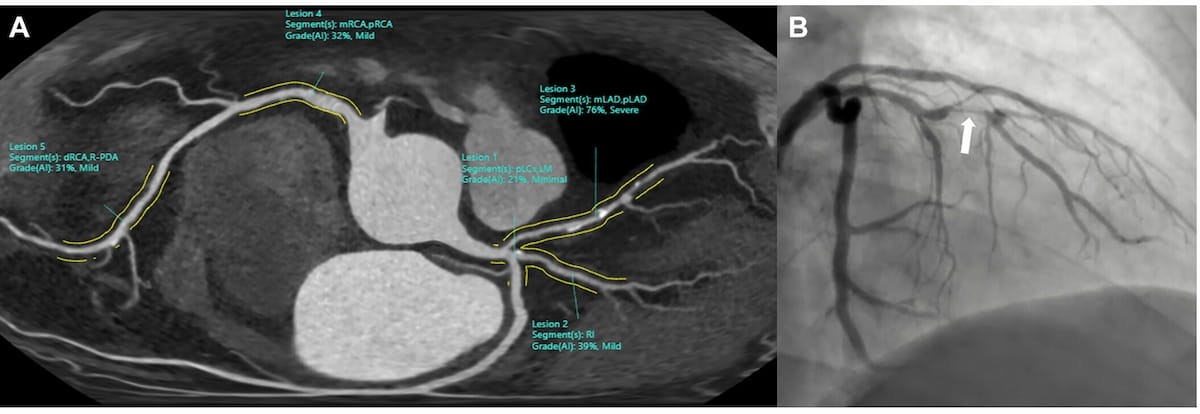Artificial intelligence (AI) software may significantly enhance coronary artery calcium scoring (CACS) and CAD-RADS stenosis severity evaluation based on coronary computed tomography angiography (CCTA) imaging.
For a new retrospective study, recently published in Radiology, researchers assessed the use of an on-premise AI software (Automated Coronary Analysis software, version 4.2.0.0, Siemens Healthineers) for 1,032 patients (median age of 62) who had a total of 1,041 CCTA exams.
Across the different thresholds of CACS such as non-zero CACS, CACS > 100 and CACS > 300, the study authors found that the AI software had a 97.3 average accuracy rate, a 96.7 percent average sensitivity rate and a 97.3 percent average specificity rate.
For CAD-RADS > 3 stenosis severity assessments, the AI software offered 87 percent accuracy, 78 percent sensitivity and 89 percent specificity, according to the researchers. For cases involving CAD-RADS > 4A evaluation, the study authors found that the AI software provided an 83 percent accuracy, 85 percent sensitivity and 83 percent specificity.
In regard to the triage capability of the AI software, the researchers pointed out a 94 percent negative predictive value (NPV) for CAD-RADS > 3 and a 98 percent NPV for CAD-RADS > 4A.
“The rising demand for CCTA underscores the need for tools that support cardiac imagers to manage increasing scan volumes. This AI tool could rapidly triage patients with chest pain at low to intermediate risk for coronary artery disease in emergency departments,” wrote lead study author Fernando U. Kay, M.D., who is affiliated with the Department of Radiology at the University of Texas Southwestern Medical Center in Dallas, Texas, and colleagues.
While the AI software offered a 90 percent per scan AUC for cases involving CAD-RADS > 3 and CAD-RADS > 4A, the study authors cautioned that the AI software had “relatively low” positive predictive values (PPVs) for CAD-RADS > 3 (65 percent) and CAD-RADS > 4A (39 percent) for detection of obstructive coronary artery disease (CAD).
Three Key Takeaways
1. High diagnostic accuracy for coronary calcium and stenosis. The AI software demonstrated excellent performance in coronary artery calcium scoring (CACS) with average accuracy, sensitivity, and specificity all around 97 percent. For CAD-RADS > 3 and > 4A stenosis severity assessments, accuracy ranged from 83 to 87 percent.
2. Effective triage tool with high NPV. With negative predictive values of 94 percent for CAD-RADS > 3 and 98 percent for CAD-RADS > 4A, the AI tool is particularly valuable for ruling out clinically significant coronary artery disease, allowing efficient triage of low- to intermediate-risk patients.
3. Potential to reduce radiologist workload. Despite lower positive predictive values (65 percent for CAD-RADS > 3 and 39 percent for > 4A), the AI system can help prioritize high-risk cases and expedite discharge decisions for low-risk patients, supporting clinicians in managing growing CCTA volumes.
However, the researchers pointed out that radiologists would still review CCTA cases flagged by AI while possibly benefitting from the potential workload reduction afforded by the high NPVs with the AI software.
“ … AI-flagged CCTA studies would still undergo expert evaluation in a traditional clinical workflow. Conversely, the high NPV offers substantial clinical value by helping to rule out clinically important coronary stenosis, thereby safely triaging patients. This will not only assist interpretation but also expedite discharge for low-risk patients and prioritize high-risk scans for timely expert review,” emphasized Kay and colleagues.
(Editor’s note: For related content, see “Medicare to Cover AI-Powered, CCTA-Based Coronary Plaque Analysis and Quantitative Coronary Topography,” “Large CT Study Shows Benefits of AI in Predicting CV Risks in Patients Without Obstructive CAD” and “Could Virtual Non-Contrast Images from Photon-Counting CT Reduce Radiation Dosing with CCTA?”)
In regard to study limitations, the authors noted the reference standard of human CCTA interpretation and acknowledged the lack of motion artifact detection and non-diagnostic segment labeling with the AI software. The researchers also conceded an inability of the AI software to detect coronary anomalies prospectively.
